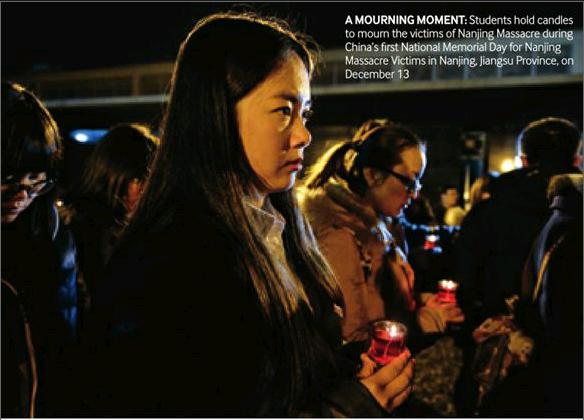Remembering Nanjing
2015-01-15ByYinPumin
By+Yin+Pumin

A state ceremony was held at the Memorial Hall of the Victims of the Nanjing Massacre by Japanese Invaders in Nanjing, east Chinas Jiangsu Province, on December 13 to commemorate those who died during the crime. It was for the countrys first National Memorial Day for Nanjing Massacre Victims.
“It was an atrocious crime and a dark page in the history of humanity,” Chinese President Xi Jinping addressed the state commemoration. “Anyone who tries to deny the massacre will not be allowed by history, the souls of the 300,000 deceased victims, the 1.3 billion Chinese people, and all people who love peace and justice in the world.”
On December 13, 1937, invading Japanese troops captured Nanjing, then Chinas capital, and began a slaughter that lasted more than 40 days. The death toll of the atrocities reached over 300,000 Chinese civilians and unarmed soldiers with 20,000 Chinese women subjected to sexual assault.
In February this year, Chinas top legislature designated December 13 as the National Memorial Day for Nanjing Massacre Victims so that the nation can mourn those killed by the Japanese invaders. The move was aimed at commemorating the calamities the war caused for the Chinese people and people around the world, conveying the Chinese peoples firm stance of resisting aggression and safeguarding human dignity and world peace, according to the decision passed by the Standing Committee of the National Peoples Congress.
The memorial ceremony started at 10 a.m. on December 13. A total of 10,000 representatives of all walks of life present at the ceremony paid silent tribute for one minute to the massacre victims as sirens howled over the city.
Sixteen honor guards laid eight wreaths in memory of the victims while the national flag flew at half-mast. Seventy-seven students read the declaration of peace.
Xi, along with Xia Shuqin, an 85-year-old survivor from the event, and a school child, unveiled a memorial ding, a type of ancient Chinese cauldron symbolizing state power and prosperity, during the ceremony. The threelegged bronze ding will be permanently placed at the square of the hall.
“The purpose of the memorial ceremony for Nanjing Massacre victims is to recall that every good-hearted person yearns for and holds a firm stance of peace, but does not try to prolong hatred,” Xi said.
The Chinese and Japanese people should live in friendship from generation to generation and work together to contribute to the peace of humanity, he said.endprint
“We should not bear hatred against an entire nation just because a small minority launched aggressive crusades. The responsibility for war crimes lies with a few militarists, but not the people. However, we cannot at any time forget the severe crimes committed by aggressors,” he said.
People who love peace and justice must remain highly cautious and firmly oppose words and actions that glorify war, he added.
In his speech, Xi expressed thanks to those of other nationalities who protected Nanjing residents and recorded the atrocities of the Japanese invaders, despite the risks.
German businessman John Rabe, Bernhard Arp Sindberg from Denmark, and U.S. priest John Magee were among the foreigners attending.
It is the third time this year President Xi has attended high-level activities related to Japanese aggression toward China.
He attended a ceremony on July 7 to mark the start of the War of Resistance Against Japanese Aggression in 1937, as well as a victory day celebration on September 3 for the 69th anniversary of the victory against Japanese aggression.
On the September 3 victory day, Xi criticized some Japanese political organizations and politicians who have challenged human conscience by denying the crimes, paying homage to the spirits of war criminals, and glorifying aggression and colonial rule.
China hopes that the Japanese Government and politicians will show respect to the people of neighboring countries and acknowledge the millions of victims in the war, he noted.
Japan invaded northeast China in September 1931, followed by a full-scale invasion that started on July 7, 1937. Around 35 million Chinese soldiers and civilians were killed or injured during the Japanese occupation, which continued until 1945.
The Hong Kong Special Administrative Region Government also held a ceremony to mark the first National Memorial Day on December 13.
Led by Hong Kong Chief Executive Leung Chun-ying, about 100 people, including senior government officials, judicial officers, Legislative Council members and representatives of war veterans attended the ceremony.
The ceremony commenced at 9 a.m. local time at the Hong Kong Museum of Coastal Defense. All participants paid two minutes of silent tribute before Leung laid a wreath to the massacre victims.
The participants then visited a photo exhibition of the Nanjing Massacre, which records the atrocities that Japanese aggressors committed against the Chinese people.endprint
Lin Zhen, 79, who began guerrilla fighting at the age of 9, recalled the sufferings of Hong Kong people during the war.
“The same as Nanjing Massacre victims, many Hong Kong people were slaughtered by Japanese aggressors. We can feel their pain. We will never forget that part of history,” she said.
Activities across the border
At the same time, some Japanese civil groups also held memorial meetings on the day to spread the truth about Nanjing Massacre and mourn the victims.
At the meeting held in front of the stone lions of Osaka Castle Park in the afternoon, Iseki, one of the organizers and member of the Osaka Stone Lions Association, said that Japan should reflect on its history of aggression and value peace.
“Nowadays some Japanese people avoid talking about or even deny the atrocities that the Japanese army committed in China during World War II, and that is wrong. Only by facing up to history, can we deal with the relationship between Japan and China in the right way and develop the friendship between the two peoples,” Iseki said.
The stone lions in Osaka Castle Park were taken from China by the Japanese invaders in 1937. In the 1980s, many Japanese citizens demanded the stone lions be returned to China. Later, the Chinese Government gave the stone lions to the Osaka City as a gift to commemorate friendship between the two peoples.
“It is of special significance to hold such a gathering in front of the stone lions, as they were both witness of the invasion and a token of friendship between the two peoples,”said Iseki.
Yamahashi, also a member of the Osaka Stone Lions Association, brought his daughter to the meeting.
“I know a few veterans who took part in the war invading China. They told me about the atrocities they committed in China. After I learned the truth about the war, I knew I had to do something,” he said.
The same night, about 100 people attended a memorial meeting for Nanjing Massacre victims in the Osaka Prefecture Youth Center.
At the meeting, a video of a Japanese veteran being interviewed was played to the audience. The veteran recalled the atrocities he committed in China during the war and talked about his remorse. After that, representatives of two civil groups gave speeches, revealing how the Japanese right-wing forces tried to hide the truth about “comfort women” and the war.endprint
A survivors testimony
On December 7, Ai Yiying, one of the around 200 living survivors of the Nanjing Massacre, shared her memory of the incident with Japanese residents at a testimony meeting in Osaka, conveying the truth about Nanjing Massacre.
The 86-year-old woman was still a little girl when Nanjing was invaded by the Japanese army in December 1937. “I was only 9 years old. One day, the Japanese soldiers came to my village, raped and killed people and burned houses,” Ai recalled.
Ais father, uncles and cousins were taken away from their home by the Japanese soldiers. Six of them were killed, and one severely injured. The rest of the family had to hide in the woods to avoid the raping and killing.
“The atrocities continued in the following months. There were dead bodies everywhere. I was afraid of dead bodies. But my mother told me what was frightening was not the dead bodies, but the Japanese soldiers, who killed them,” Ai said.
Ai was invited by the Chinese War Victims Testimony Meeting Committee in Japan to share her story. More than 100 Japanese residents attended the testimony meeting. When Ai finished telling her experience, all attendants of the meeting stood up and mourned in silence for the victims of Nanjing Massacre.
The testimony meeting has been an annual tradition since 1994. So far, a total of 51 survivors have attended the testimony meetings in 36 different groups.
“Its been 77 years. We shall always remember this history, and by doing that, value peace and warn people never to let such tragedy happen again,” Ai said.
In China, a project of publishing oral testimonies of 100 Nanjing Massacre survivors began in September.
“The most powerful evidence is no doubt the narrations of survivors themselves,” said Fei Zhongxing, a researcher on the Nanjing Massacre.endprint
